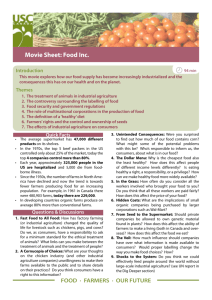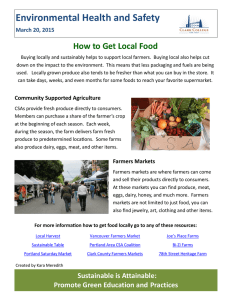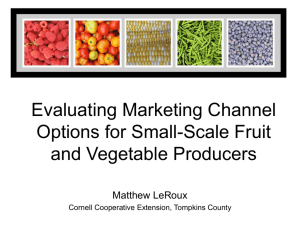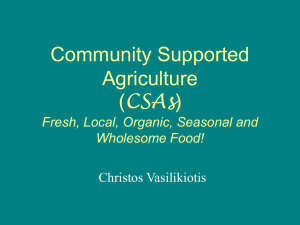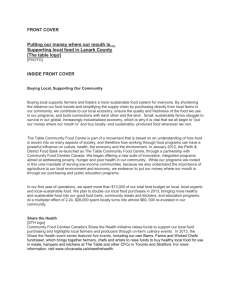Marketing Strategies of Exemplary Organic Farmers
advertisement
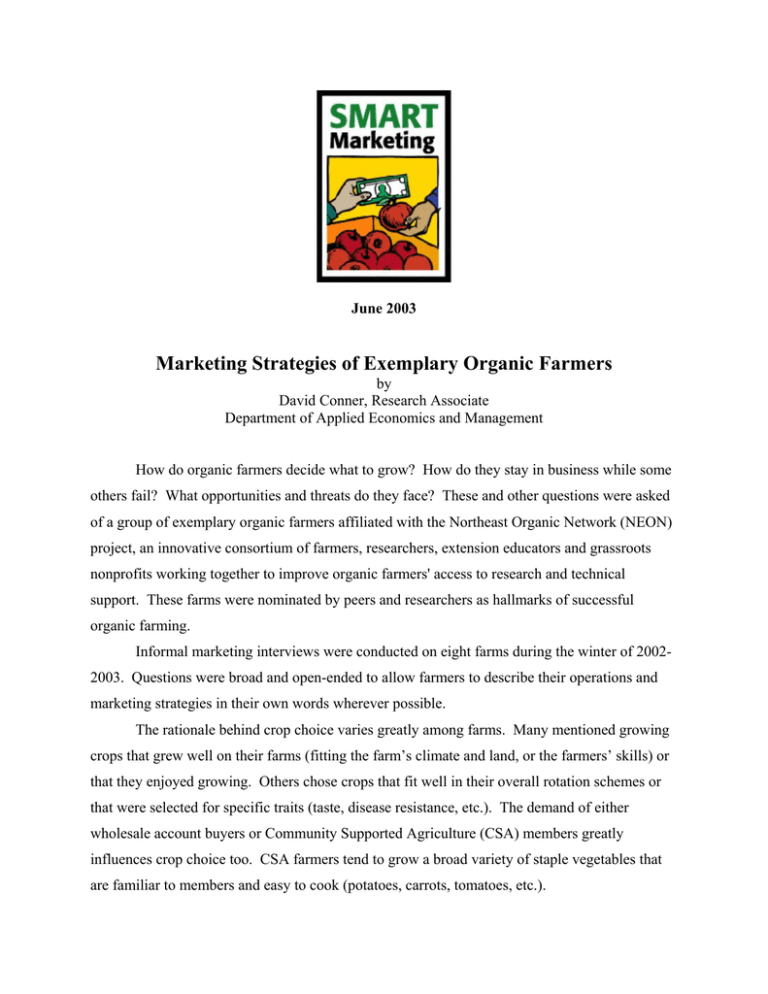
June 2003 Marketing Strategies of Exemplary Organic Farmers by David Conner, Research Associate Department of Applied Economics and Management How do organic farmers decide what to grow? How do they stay in business while some others fail? What opportunities and threats do they face? These and other questions were asked of a group of exemplary organic farmers affiliated with the Northeast Organic Network (NEON) project, an innovative consortium of farmers, researchers, extension educators and grassroots nonprofits working together to improve organic farmers' access to research and technical support. These farms were nominated by peers and researchers as hallmarks of successful organic farming. Informal marketing interviews were conducted on eight farms during the winter of 20022003. Questions were broad and open-ended to allow farmers to describe their operations and marketing strategies in their own words wherever possible. The rationale behind crop choice varies greatly among farms. Many mentioned growing crops that grew well on their farms (fitting the farm’s climate and land, or the farmers’ skills) or that they enjoyed growing. Others chose crops that fit well in their overall rotation schemes or that were selected for specific traits (taste, disease resistance, etc.). The demand of either wholesale account buyers or Community Supported Agriculture (CSA) members greatly influences crop choice too. CSA farmers tend to grow a broad variety of staple vegetables that are familiar to members and easy to cook (potatoes, carrots, tomatoes, etc.). Quality of product and service are two commonly mentioned competitive advantages on these farms. Given the seasonal and scale limitations of northeast farms, they rely largely on niche markets and personal relationships with their consumers or buyers. They focus on providing a higher level of service and quality to set them apart and keep their customers from buying from cheaper or more convenient mass channels. “The customer is always right,” one grower states; providing low quality or service even one time may well lose the customer forever. One farm grows 55 varieties of heirloom tomatoes, paying special attention to flavor rather than high yield, long shelf life, or other traits emphasized by large-scale organic growers. In growers’ minds, education is another key feature to customer retention. One farm creates and distributes point-of-purchase materials on the produce, describing how it tastes and how to cook it. The farmers hold “taste-offs” for tomato varieties. CSA farms hold open houses, picnics and farm tours to emphasize the social aspect of CSA, build relationships between grower and consumer, and teach about farming practices and land stewardship. Many mentioned that building relationships and addressing consumers by name are vital. Many farmers see a growing opportunity in the increased popularity of and media attention upon organics and consumers’ desire to “know where food comes from.” They felt that markets for organic grain farmers are currently fairly good, although the future is uncertain. Most of the vegetable farmers continue to operate on a small scale. While this poses a challenge when competing with larger growers, it also enables them to respond quickly and nimbly to changing demands and market conditions, and grow a diversity of crops. Despite their successes, these farmers see threats in current trends as well. Increased imports of food threaten farm prices; increased demand for organics has brought competition in the form of new or transitioning farmers. The National Organic Program brings greater scrutiny and a more rigorous inspection process, as well as uncertainty as to rule changes. Grain farmers are also concerned about seed availability (finding seed that both meets the traits their buyers desire and grows well organically in their regions) and the impact of pollen drift from genetically modified crops. Finding adequate labor supply is an ongoing challenge for many farms. Concerning the “Four Ps” of marketing (product, place, price, promotion), there was a consensus on the need for high quality, but disagreement on price. Some farms, especially smaller ones more reliant on direct marketing, maintain a high price to reflect the premium quality of food and refuse to lower it. Other farms set it lower than the equivalent prices in 2 grocery and health food stores and fear raising it because of customers’ past expectations. Place varies from on-farm CSA pickups to wholesale deliveries to big cities. The degree of promotion varies, too, from word-of-mouth to brochures, websites and advertisements in holistic magazines and newsletters. Each farm is unique in its marketing strategies and view of the future, but it is clear that there is a place in the American agricultural landscape for high quality organic food from farms willing to create and nurture niche markets. Matching the market to the grower is more art than science, and depends greatly on the farmer’s skills, interests and personality. Finding those opportunities is a challenge to growers, researchers and extension educators. "Smart Marketing" is a monthly marketing newsletter for extension publication in local newsletters and to place in local media. It reviews the elements critical to successful marketing in the food and agricultural industry. Articles are written by faculty members in the Department of Applied Economics and Management at Cornell University "Share the gift of communication." Please cite or acknowledge when using this material. 3
